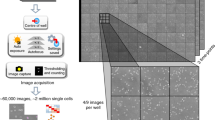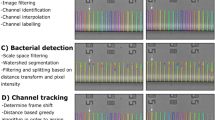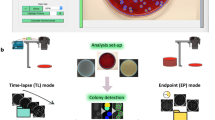Abstract
Observations of real-time changes in living cells have contributed much to the field of cellular biology. The ability to image whole, living cells with nanometre resolution on a timescale that is relevant to dynamic cellular processes has so far been elusive1,2. Here, we investigate the kinetics of individual bacterial cell death using a novel high-speed atomic force microscope optimized for imaging live cells in real time. The increased time resolution (13 s per image) allows the characterization of the initial stages of the action of the antimicrobial peptide CM15 on individual Escherichia coli cells with nanometre resolution. Our results indicate that the killing process is a combination of a time-variable incubation phase (which takes seconds to minutes to complete) and a more rapid execution phase.
This is a preview of subscription content, access via your institution
Access options
Subscribe to this journal
Receive 12 print issues and online access
$259.00 per year
only $21.58 per issue
Buy this article
- Purchase on Springer Link
- Instant access to full article PDF
Prices may be subject to local taxes which are calculated during checkout




Similar content being viewed by others
References
Dufrene, Y. F. Using nanotechniques to explore microbial surfaces. Nature Rev. Micro. 2, 451–460 (2004).
Dufrene, Y. F. Towards nanomicrobiology using atomic force microscopy. Nature Rev. Micro. 6, 674–680 (2008).
Matzke, R., Jacobson, K. & Radmacher, M. Direct, high-resolution measurement of furrow stiffening during division of adherent cells. Nature Cell. Biol. 3, 607–610 (2001).
Muller, D. J., Baumeister, W. & Engel, A. Controlled unzipping of a bacterial surface layer with atomic force microscopy. Proc. Natl Acad. Sci. USA 96, 13170–13174 (1999).
Muller, D. J., Fotiadis, D., Scheuring, S., Muller, S. A. & Engel, A. Electrostatically balanced subnanometer imaging of biological specimens by atomic force microscope. Biophys. J. 76, 1101–1111 (1999).
Plomp, M., Leighton, T. J., Wheeler, K. E., Hill, H. D. & Malkin, A. J. In vitro high-resolution structural dynamics of single germinating bacterial spores. Proc. Natl Acad. Sci.USA 104, 9644–9649 (2007).
Francius, G., Domenech, O., Mingeot-Leclercq, M. P. & Dufrene, Y. F. Direct observation of Staphylococcus aureus cell wall digestion by lysostaphin. J. Bacteriol. 190, 7904–7909 (2008).
Hinterdorfer, P., Baumgartner, W., Gruber, H. J., Schilcher, K. & Schindler, H. Detection and localization of individual antibody–antigen recognition events by atomic force microscopy. Proc. Natl Acad. Sci. USA 93, 3477–3481 (1996).
Muller, D. J. & Dufrene, Y. F. Atomic force microscopy as a multifunctional molecular toolbox in nanobiotechnology. Nature Nanotech. 3, 261–269 (2008).
Ando, T. et al. A high-speed atomic force microscope for studying biological macromolecules. Proc. Natl Acad. Sci. USA 98, 12468–12472 (2001).
Kobayashi, M., Sumitomo, K. & Torimitsu, K. Real-time imaging of DNA–streptavidin complex formation in solution using a high-speed atomic force microscope. Ultramicroscopy 107, 184–190 (2007).
Hansma, P. K., Schitter, G., Fantner, G. E. & Prater, C. Applied physics—high-speed atomic force microscopy. Science 314, 601–602 (2006).
Dufrene, Y. F. Atomic force microscopy and chemical force microscopy of microbial cells. Nature Protocols 3, 1132–1138 (2008).
Fantner, G. E. et al. Components for high speed atomic force microscopy. Ultramicroscopy 106, 881–887 (2006).
Viani, M. B. et al. Fast imaging and fast force spectroscopy of single biopolymers with a new atomic force microscope designed for small cantilevers. Rev. Sci. Instrum. 70, 4300–4303 (1999).
Tiozzo, E., Rocco, G., Tossi, A. & Romeo, D. Wide-spectrum antibiotic activity of synthetic, amphipathic peptides. Biochem. Biophys. Res. Commun. 249, 202–206 (1998).
Gottlieb, C. T. et al. Antimicrobial peptides effectively kill a broad spectrum of Listeria monocytogenes and Staphylococcus aureus strains independently of origin, sub-type or virulence factor expression. BMC Microbiol. 8, 205 (2008).
Hancock, R. E. W. & Sahl, H. G. Antimicrobial and host-defense peptides as new anti-infective therapeutic strategies. Nature Biotechnol. 24, 1551–1557 (2006).
Loose, C., Jensen, K., Rigoutsos, I. & Stephanopoulos, G. A linguistic model for the rational design of antimicrobial peptides. Nature 443, 867–869 (2006).
Andreu, D. et al. Shortened cecropin-a melittin hybrids—significant size-reduction retains potent antibiotic-activity. FEBS Lett. 296, 190–194 (1992).
Kalfa, V. C. et al. Congeners of SMAP29 kill ovine pathogens and induce ultrastructural damage in bacterial cells. Antimicrob. Agents Chemother. 45, 3256–3261 (2001).
Meincken, M., Holroyd, D. L. & Rautenbach, M. Atomic force microscopy study of the effect of antimicrobial peptides on the cell envelope of Escherichia coli. Antimicrob. Agents Chemother. 49, 4085–4092 (2005).
Mangoni, M. L. et al. Effects of the antimicrobial peptide temporin L on cell morphology, membrane permeability and viability of Escherichia coli. J. Peptide Sci. 10, 859–865 (2004).
Bechinger, B. The structure, dynamics and orientation of antimicrobial peptides in membranes by multidimensional solid-state NMR spectroscopy. Biochim. Biophys. Acta Biomembranes 1462, 157–183 (1999).
Ladokhin, A. S., Selsted, M. E. & White, S. H. Sizing membrane pores in lipid vesicles by leakage of co-encapsulated markers: pore formation by melittin. Biophys. J. 72, 1762–1766 (1997).
Lee, M. T., Hung, W. C., Chen, F. Y. & Huang, H. W. Mechanism and kinetics of pore formation in membranes by water-soluble amphipathic peptides. Proc. Natl Acad. Sci. USA 105, 5087–5092 (2008).
Sato, H. & Feix, J. B. Osmoprotection of bacterial cells from toxicity caused by antimicrobial hybrid peptide CM15. Biochemistry 45, 9997–10007 (2006).
Ferullo, D. J., Cooper, D. L., Moore, H. R. & Lovett, S. T. Cell cycle synchronization of Escherichia coli using the stringent response, with fluorescence labeling assays for DNA content and replication. Methods 48, 8–13 (2009).
Alsteens, D. et al. Organization of the mycobacterial cell wall: a nanoscale view. Pflug. Arch. Eur. J. Phy. 456, 117–125 (2008).
Albeck, J. G. et al. Quantitative analysis of pathways controlling extrinsic apoptosis in single cells. Mol. Cell 30, 11–25 (2008).
Acknowledgements
The authors would like to thank T. Chau for helpful discussions about antimicrobial peptides. G.E.F. is supported by an Erwin- Schrödinger fellowship J2778-B12. R.J.B. is the recipient of a National Institutes of Health Biotechnology Training Program Fellowship. A.M.B. would like to thank the Massachusetts Institute of Technology for their generous support. This work was further funded by the Army Research Office through the Institute for Soldier Nanotechnology, the National Institute of Health under Award RO1 GM065354 and by the Austrian Research Promotion Agency under award no. VO156-08-BII: NSI-FABICAN.
Author information
Authors and Affiliations
Contributions
G.E.F. and R.J.B. contributed to experimental design and execution and writing of the manuscript. D.S.G. designed the methods and sample preparation. A.M.B. contributed to experimental design, supervision and editing of the manuscript.
Corresponding author
Ethics declarations
Competing interests
The authors declare no competing financial interests.
Supplementary information
Supplementary information
Supplementary information (PDF 1515 kb)
Rights and permissions
About this article
Cite this article
Fantner, G., Barbero, R., Gray, D. et al. Kinetics of antimicrobial peptide activity measured on individual bacterial cells using high-speed atomic force microscopy. Nature Nanotech 5, 280–285 (2010). https://doi.org/10.1038/nnano.2010.29
Received:
Accepted:
Published:
Issue Date:
DOI: https://doi.org/10.1038/nnano.2010.29
This article is cited by
-
Surveying membrane landscapes: a new look at the bacterial cell surface
Nature Reviews Microbiology (2023)
-
Visualizing the membrane disruption action of antimicrobial peptides by cryo-electron tomography
Nature Communications (2023)
-
Dynamic monitoring of oscillatory enzyme activity of individual live bacteria via nanoplasmonic optical antennas
Nature Photonics (2023)
-
Long-term label-free assessments of individual bacteria using three-dimensional quantitative phase imaging and hydrogel-based immobilization
Scientific Reports (2023)
-
Efficient in planta production of amidated antimicrobial peptides that are active against drug-resistant ESKAPE pathogens
Nature Communications (2023)



